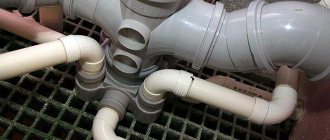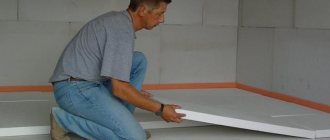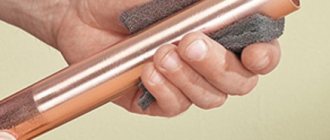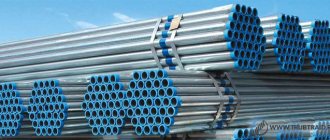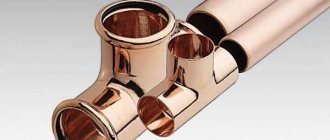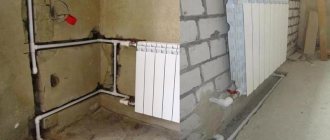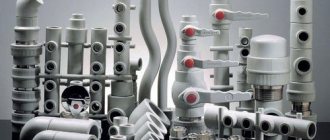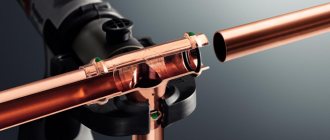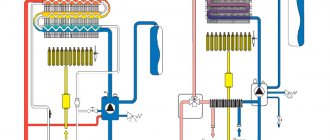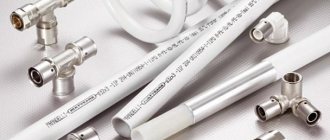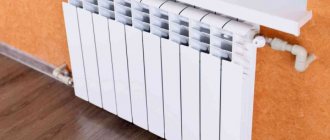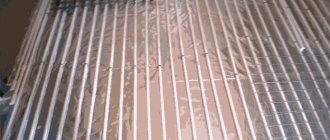What is copper pipe
Copper pipes are considered the most expensive.
They are pink-red in color, with a smooth, shiny surface. They are made from special purified copper, which is 99.9% chemically pure metal.
Peculiarities:
- Bends of small diameters, with thin walls, are not inferior to their steel counterparts in strength.
- They have elasticity, flexibility, and an aesthetic appearance.
Specifications
In its basic properties - electrical conductivity and thermal conductivity - copper is second only to silver.
The material is plastic, which makes it easy to process by cold and hot rolling.
Copper communications are resistant to corrosion, their service life is practically unlimited.
The products have a smooth surface. Suffice it to say that the roughness of their walls is a hundred times lower than that of iron pipes. Their throughput capacity remains unchanged throughout their operation.
The main technical characteristics of copper taps include:
- External section of the outlet.
- Wall thickness.
- Length of the product.
Areas of application
This is an ideal material for:
- Air conditioning systems.
- Heating.
- Refrigeration units.
- Cold and hot water supply.
The properties of high heat transfer make it possible to use copper taps in computer coolers, heat pipes, heat exchangers, and cooling radiators.
Reliably and safely use copper pipes to carry out gas distribution in an apartment building. The investment more than pays off with reliable tightness and long-term service of the gas pipeline.
Copper bends are used in the manufacture of household appliances and chemical equipment.
As for soft (annealed) pipes, they are widely used in air conditioning and refrigeration, with certain restrictions they are suitable for water supply and heating systems.
Kinds
Copper pipes that have undergone special heat treatment (heating up to 700ºC) become more ductile and flexible. Such pipes are called annealed. Flexible copper pipes are produced in sections of several tens of meters (up to 50 m).
Thin-walled copper pipes are made from copper alloys M1, M2, M3. The diameter of thin-walled pipes can be from 3 mm to 28 mm, with a wall thickness from 0.15 mm to 0.70. It is produced either in coils or in lengths of three meters. It is possible to produce thin-walled pipes of other sizes, at the request of the customer. Thin-walled copper tubes are used in systems where lightweight and durable communications are needed, for example, in hydraulic and pneumatic systems in shipbuilding, automotive, and aviation.
Copper pipes in the water supply system.
In terms of cross-sectional shape, in addition to the traditional round shape, copper pipes can be rectangular. Side dimensions can be from 10 mm to 50 mm, with wall thicknesses from 0.8 mm to 3 mm. Rectangular copper pipes are used in the production of parts in the field of instrumentation and mechanical engineering.
Corrugated copper pipe is used for laying highways in cramped conditions when the use of traditional pipes is not possible.
Copper pipes can additionally be chrome-plated, due to which they acquire a more aesthetic appearance. Such pipes are used in plumbing, where durable, but at the same time visually attractive metal products are required.
Finned copper pipes can be monometallic (made by casting) or bimetallic (made by rolling, pouring, heating with high frequency current), and are used as a heat exchanger.
Due to the high strength characteristics and high thermal conductivity of copper pipes, when using them, it is possible to install closed-type wiring, which is very important when installing a heated floor system.
Plumbing copper pipe is the most reliable and durable product of all existing ones. If copper pipe is used for cold water supply systems, it is recommended to use plastic-coated copper pipes.
The greatest demand is for copper pipes with a cross-section of up to 10 mm: diameter 1/4˝ (6.35x0.76 mm) and diameter 3/8˝ (9.53x0.81 mm), pipes of these sizes are used mainly in air conditioning systems air and refrigeration equipment.
What is the difference between an annealed copper pipe and an unannealed one?
The differences are due to additional annealing of the resulting rolled metal.
Unannealed (solid) pipes are obtained by drawing, rolling or pressing. Their tensile strength is 340-450 MPa, and their deformation limit is 6%.
To produce a soft tap, the finished product is subjected to additional firing - heating to 600-700 degrees. Thanks to heat treatment, annealed copper bends acquire greater ductility and flexibility (the tensile limit reaches 40% of the original length).
They are produced in coils 25 or 50 meters long.
This technology is the difference between unannealed (solid) and annealed types.
Due to their plasticity, annealed bends acquire such advantages as the ability to:
- Accelerated installation of pipelines of complex configurations.
- Deform and then return to its original shape under mechanical influence. It is enough to note that annealed products can withstand up to 5 freezing cycles without any damage.
The cost of annealed products is slightly higher than their unannealed counterpart.
Technology for the production of annealed and unannealed pipes
The process looks like this:
- Copper production begins with the extraction of raw materials. Mined ores are processed at processing plants.
- Copper concentrates are produced from enriched ore, from which blister copper with a purity of 98-99% is smelted into ingots.
- From these ingots, pipe blanks are produced either by hot pressing or hot rolling. Next, they go through the stages of cold wire rod, then cold drawing, where they are given the required standard sizes.
- The final operations are annealing and finishing drawing. Soft or annealed pipes are subjected to additional annealing - heating up to 700 degrees. After cooling, the products acquire the required characteristics.
Scope of application of copper pipes
One of the most popular non-ferrous metal products is copper pipes.
The production and use of copper pipes is primarily determined by the properties of copper, which can withstand the external environment and aggressive factors affecting the metal.
But in this article we will not dwell particularly on the properties of copper or the stages of production of copper pipes. We will talk about the applications of copper pipes.
1. Plumbing.
Copper pipes have been used in this area for quite a long time; first of all, this choice is due to their corrosion resistance, which is very important for contact with water. In addition, copper pipes can be subjected to long-term use.
In addition, copper pipes are chemically inert to chlorine and have bactericidal properties.
A large assortment of copper pipes allows them to be used for a wide variety of plumbing tasks. Unlike steel pipes, copper pipes are not afraid of water freezing in winter, because copper is a plastic material, which is important in this situation.
Due to their internal smoothness, copper pipes, compared to steel and plastic, with equal diameters, have an order of magnitude better throughput.
Another important feature of copper water supply is its ability to withstand pressure from 22 to 230 atmospheres at a liquid temperature of up to 100 degrees. When compared with steel and metal-plastic pipes, the latter simply cannot withstand such loads and “break.”
2. Heating systems.
Using copper pipes for heating has a double effect:
1). Long service life due to copper resistance to corrosion.
2). Protecting the system from an uncontrolled increase in coolant temperature. Copper can withstand temperatures up to 250 degrees and pressure surges due to its ductility.
The only condition that must be observed when installing a heating system is the combination of copper pipes with aluminum and steel elements in a certain sequence. Pipes and other metals (if the main one is copper) must be placed in front of copper ones, otherwise electrochemical corrosion will occur.
3. Fuel pipelines.
Due to its exceptional tightness and neutral properties, copper pipes are used to create fuel pipelines, for example, for pumping fuel oil.
4. Gas pipelines.
The use of copper allows you to make indoor wiring without welding; the reliability and tightness of connections using soldering or pressing is extremely high. Which in turn reduces the risk of gas leaks and emergency situations.
5. Industry.
The best confirmation of the quality of copper pipe products is the choice of industrial enterprises.
The best and highest quality gas water heaters, brake systems, hydraulic systems, capillary tubes, use copper pipes. In addition, copper pipes are used in mechanical engineering, aircraft manufacturing, climate control and refrigeration equipment.
Naturally, one of the most important issues when choosing pipes is the price; sometimes it is more profitable to use cheap and short-lived materials than very expensive but durable analogues.
But copper is not this option; of course, copper pipes are more expensive than steel ones, but the price of rolled copper pipes is not so high as to cover the advantages that they have.
Our company sells the entire range of copper pipe products at low prices while maintaining high quality. For information, please contact the sales department, whose phone numbers are located in the contacts section.
Normative documents
In Europe, the quality of copper bends is regulated by the EN 1057 standard. Pipeline products manufactured in accordance with the norms of this standard bear the “DVGW” mark.
In Russia, the industrial production of copper bends is regulated by GOSTs, as well as technical specifications developed by manufacturers and approved by standardization bodies.
GOST requirements and dimensions according to the standard
Domestic standards are in many ways close to pan-European standards or completely synchronized with their norms. Thus, a copper pipe for home water supply, manufactured according to GOST 52318, complies with international EN 1057.
The main Russian regulatory document regulating copper pipe products is GOST-617-2006. He establishes the grades of copper that are used for the manufacture of bends and the standard sizes of products.
The chemical composition of copper products is established by GOST 859-2001.
A number of standards regulate the production of certain types of copper bends. For example, GOST 11383 75 regulates the production of thin-walled round drawn copper and brass tubes.
The dimensions of the bends are determined by the external cross-section, length and thickness of the wall. The range of external diameter sizes is from 0.35 mm to 360 mm.
Wall thickness varies from 0.05 to 30 mm. In terms of length, solid bends are produced in sizes from 3 to 5 meters, annealed ones are wound into coils of 25-50 m.
Specifics of measuring copper pipes
When choosing pipe products or fittings, the buyer often comes across the term “inch pipe”. Here we must keep in mind that, traditionally, the internal diameters of bends are measured in inches and its fractions.
Inch copper pipes were used frequently in the 90s. They are not currently on sale. The current standard specifies the size of the outer diameter in millimeters, as well as the wall thickness of copper taps.
The internal cross-section is calculated by subtracting twice the wall thickness in millimeters from the external cross-section. Conversion to inches is carried out based on the value: 1 inch equals 25.4 cm.
Rules for selecting pipes for various systems
Each pipeline has special characteristics, so when choosing pipes, all parameters should be taken into account.
Selection of pipes for water supply and wastewater systems
For the water supply system, round pipes with a diameter of 8 mm - 22 mm are mainly used. The wall thickness of such pipes does not exceed 1 mm.
To determine the optimal outer diameter of copper pipes for an indoor water supply system, experts use a complex mathematical formula. A simpler way to determine the diameter is as follows:
- if the pressure in the water supply system exceeds 3 atmospheres, then the minimum diameter is 8 mm;
- if more than one water tap is connected to the collector, then the minimum pipe diameter is 15 mm;
- if the water supply system is connected from a central collector, then the first connecting copper pipe with a diameter of 20 mm is installed;
- if water is supplied to the system under a pressure of less than 2 atmospheres, then the diameter of the installed pipes increases accordingly by one standard size, that is, instead of 8 mm, 10 mm should be used and so on (table of standard sizes below);
- if the length of a private water supply from the point of entry to the points of consumption is more than 20 m, then in order to obtain normal water pressure in all devices it is necessary to increase the nominal sizes of the pipes by one standard size.
Standard Typical Parameters of Copper Pipe
For drainage systems, pipes with a diameter of 32 mm to 42 mm are used.
Selection of pipes for the heating system
To calculate the diameter of the pipe in heating systems, the following parameters are used:
- pipeline layout;
- pipe resistance coefficient;
- speed of coolant movement in the system;
- diameters of inlet and outlet holes.
It is almost impossible to determine the diameter of the pipes on your own due to the complexity of the calculations, so to determine the parameter you can use the table below or the calculation method.
Calculation of the optimal pipe diameter for the heating system
The diameter of the pipe in the heating system cannot be greater than the outlet diameter of the heating equipment.
Copper pipes in the heating system are described in detail in the video.
Selection of pipes for gas supply
Depending on the pressure in the system, gas pipelines are divided into the following types:
- with low pressure (less than 0.005 MPa);
- with average pressure (0.005 MPa - 0.3 MPa);
- with high pressure (more than 0.3 MPa).
Copper pipes are allowed to be used exclusively for the installation of gas pipelines with low and medium pressure, that is, for domestic gas pipelines.
Recommend: Heat Resistant Oven Sealant, High Temperature Chimney Sealant
According to regulatory documents, copper pipes are used for pipeline laying:
- with a diameter of no more than 15.9 cm;
- wall thickness up to 5 mm.
A more accurate calculation of the diameter is made exclusively by specialists.
Advantages and disadvantages
Let's look at the pros and cons of copper pipes.
Their positive qualities include:
- High values of electrical conductivity and thermal conductivity.
- Excellent strength with thin walls, comparable to steel pipes.
- Corrosion resistance, long service life reaching 100 years.
- Ability to withstand high temperature changes (from -100 to +250 C).
- Susceptibility to various processing options: soldering, welding, pressure methods, cutting.
Experts also find disadvantages to copper taps:
- In an environment saturated with moisture and containing carbon dioxide, the surface of the bends becomes covered with a greenish coating (patina). However, it is not recommended to clean it off, since it plays the role of a protective layer.
- High cost, although professional installers claim that with skillful use of copper products it is comparable to polymer samples.
- The occurrence of corrosion in places of contact with other metals, intersection of electrically conductive wires.
- The diameter of the soft pipe is limited to 28 mm.
- It is almost impossible to align an annealed bend into a perfect straight line. Therefore, an open system of such products looks untidy. But for hidden installation it is suitable.
Another controversial opinion: copper pipes are not suitable for drinking water. Copper ions entering water are harmful to the human body.
Opponents of this point of view argue that copper products are actively used abroad for water supply systems.
When is it appropriate to use copper pipes?
Copper pipes provide high resistance to temperatures exceeding 100˚C, which exist in central heating systems that operate on solid fuel boilers.
You can lay pipes on the wall without losing the aesthetic appearance.
If the heating and water supply system has many branches and involves installing a large number of fittings, then this reduces the cost of installation despite all the advantages of copper pipes and makes their use more expedient compared to other materials.
The durability of copper pipes is comparable to the life of a house, so if there are no financial restrictions, the installation of such pipes will be justified.
How to decipher the markings
The labeling indicates:
- Manufacturer.
- Production method - D (cold rolled).
- Section profile - KR (round).
- Accuracy class - N (normal), P (increased).
- Product type - M (soft), P (semi-rigid), T (hard pipe).
- Length - CD (multiple of measured), ND (unmeasured).
Marking example:
Cold-rolled pipe, round, high precision, soft, with an external cross-section of 28 mm and a wall of 3 mm, 5 meters long, copper grade M3:
Pipe DKRM 28×3×5000 M3 GOST 617-2006.
First, it is determined which type of pipeline to choose: hard or soft. They are guided by the purpose of the system and the feasibility of using one type or another. It should be kept in mind that annealed pipes are limited to a cross-section of 28 mm.
Considering the high cost of copper bends, it is necessary to make a laying diagram in advance and calculate the required amount of materials.
If pipes are selected for a heating system, then it is not recommended to buy annealed pipe. As already noted, it is very difficult to align it and it will look unaesthetic in open wiring.
Marking and diameter
Information about product parameters can be obtained from the labeling. We are talking about the diameter of the outlet. It is indicated by the first digit after the pipe designation. In the same way, the section size is indicated on store price tags.
For home networks, copper pipes with a cross section of 15 and 20 mm are considered a common option.
Popular manufacturers
Products from German, MKM GmbH (MKM), Wieland, Italian, Serbian and SEVOJNO (Serbia) are widely popular on the Russian market.
Among Russian manufacturers, the leader is the famous one, which, in particular, owns factories in the city of Majdanpek (Serbia) and in the city of Revda (Sverdlovsk region).
The sanitary products of Kolchuginsky and Kirovsky ZOTsM are distinguished by their high quality.
Main characteristics of copper products
The main operational characteristics of copper pipes are regulated by GOST. According to the regulatory document, copper products can be made from alloys. One of the most used alloys is brass. By adding other elements, it is possible to obtain a material with different properties. But the main characteristics of copper products are:
- High corrosion resistance;
- Flexibility;
- UV resistance;
- High resistance to temperature changes;
- High thermal conductivity;
- Strength;
- Environmental friendliness;
- Vibration resistance;
- Long service life.
Copper products are 100% recyclable. Their only drawback is their relatively high cost.
Copper products
In order for copper products to serve for many years, it is necessary to take into account their purpose, as well as:
- Dimensions;
- Diameters;
- Wall thickness;
- System pressure;
- Availability of insulation.
In accordance with the standard sizes, the pipe can be:
- Thin-walled;
- Thick-walled.
Thin-walled pipe is used in those areas where a lightweight and at the same time durable communication system is needed (in shipbuilding, automotive industry, aviation). A thick-walled pipe has increased strength, which is why it is used when transporting liquid and gaseous substances. Thick-walled pipe is manufactured in the following ways:
- Welded;
- Seamless.
Copper pipes for heated floors
Also, according to the standards, the range of copper products can be of different sections:
- Round;
- Rectangular;
- Square.
A round pipe is intended for plumbing and heating systems, while a rectangular profile pipe is intended mainly for mechanical engineering. The profile pipe has the following positive characteristics:
- Does not deform;
- Has high strength;
- Withstands heavy loads;
- Has relatively light weight.
The profile pipe has excellent load resistance, therefore it is practically indispensable in construction, as well as in the automotive industry. In order to make sure that the product meets all quality standards, it is necessary to compare its actual weight with the weight according to GOST.
Installation features
Copper pipes are convenient and easy to install, bending and cutting.
Copper fittings are available in various sizes for arranging branches and turns. According to the technology, it is possible to use connectors made of brass, bronze, stainless steel and heat-resistant polymers.
A reliable joining method is soldering.
Solder connection
There are hard and soft soldering methods.
Hard is used in extreme cases, since after it the connection has an unpleasant black appearance that cannot be improved or hidden.
Soldering is done using a gas torch. The process temperature reaches 450 degrees. Refractory solders are used to create the connection.
A rigid connection is used for pipes with a cross-section from 12 to 159 mm, in gas pipelines, for assembling home water supply.
Compression fitting
There are two methods of connecting with compression fittings:
- Crimping and collapsible.
- Press fittings.
The first method is to put a nut, ferrule, and connector body on the pipe, and then screw the nut onto the ring. It compresses the pipe and creates a strong joint.
There are two nuances here:
- It is difficult to tighten the nut with precisely adjusted force. If you tighten the connection a little, the thin walls of the pipe are damaged with all the ensuing consequences.
- The unit is considered a detachable and repairable connection. In practice, you can disassemble a compression fitting, but you cannot remove the ferrule. It will stick firmly into the copper wall and cannot be removed without damaging the pipe.
Press fittings are definitely more reliable. But to install them you need sets of special keys and an expensive press. Rare craftsmen go to such expense.
How to solder with soft solder
Algorithm:
- When low-temperature or soft soldering, the joint is heated to 250-300 C. As a result, a capillary effect is created, the molten solder spreads over the joint surface. It is necessary to maintain the recommended gap between the fitting and the outlet - 0.1 mm.
- Clean pipes and fittings before operation. Apply a special paste to the fitting and pipe. Heat the joint with a burner until the color of the copper changes. Carefully apply solder around the perimeter of the connection. It should melt from the hot surface of the parts.
- Allow the material to cool. Remove traces of flux.
The connection is ready.
Carrying out the necessary calculations
Before purchasing the material, make a plan diagram of the future installation.
It is better to draw a diagram on the wall or other direct installation location indicating joints, fastening points, and location of fittings. This will allow you to accurately determine the sizes of sections, straight pipes, and the number of connectors.
When determining the diameter size, you should be guided by the following:
- If an old pipeline is being replaced and it was functioning normally, then it makes sense to leave the internal diameter the same.
- If pipes are installed in a new house, a heating system with an area of 100 m2 will require copper pipes with an external cross-section of 22 mm for risers and outlets, and 15-18 mm for supply to radiators.
How to bend
Copper pipes can be bent by hand. Especially annealed ones, which have to be straightened manually before installation. However, the copper pipe suddenly breaks or becomes wrinkled.
Therefore, for these purposes it is better to use the following devices:
- A regular crossbow pipe bender.
- A spring that is put on the outlet and bends.
- Bend using sand poured into the pipe cavity.
Each method will work more efficiently if the copper tap is slightly heated beforehand.
Use of copper piping
The anti-corrosion properties of copper, its ductility, thermal stability, and high thermal conductivity allow the use of products made from this metal in air, heating, water supply and insulating communications.
We recommend that you read: The use of plastic pipes for organizing drainage systems
Depending on the diameter, copper pipes are used:
- In air conditioning and convector heating systems. Here they use light, thin-walled products with a diameter of 8-10 mm.
- In refrigeration units.
- In water supply systems for “home” wiring. Use pipes 15-25 mm in diameter.
- In autonomous heating systems. Diameter from 20 to 32 mm.
- The drainage system uses pipes of the largest diameter. The drain is installed with a diameter of 40-50 mm.
Due to their durability and noble appearance, copper pipes are often used as an interior item that serves as an insulator for electrical wiring.
Note! The installation of copper pipelines has its own specifics, since the connection of pipes and fittings is carried out without the use of threads.
Pros and cons of copper pipes
The advantages of the copper products under consideration in the following aspects:
- Economical
. The combination of ease of processing, forming and joining means savings on installation, time and material. Long-term performance and reliability make copper a cost-effective piping material. - Molding
. Soft copper pipe can accept any bend or angle. - Versatility
. The products are used in many areas and for various needs. - Excellent thermal conductivity
. A copper pipeline, provided there is no insulation, can serve as a heating device. - Safety
. The products do not support combustion and do not emit toxic gases. - Durability
. Such pipes are characterized by high mechanical strength, heat resistance and resistance to ultraviolet decomposition.
Despite the abundance of positive qualities, copper pipes also have disadvantages.
- Use of thermal insulation. This will reduce heat losses, but additional expenses are required.
- Electrical conductivity. A high conductivity coefficient can attract stray currents.
- Technically, installation is more complex than for products made from other materials.
